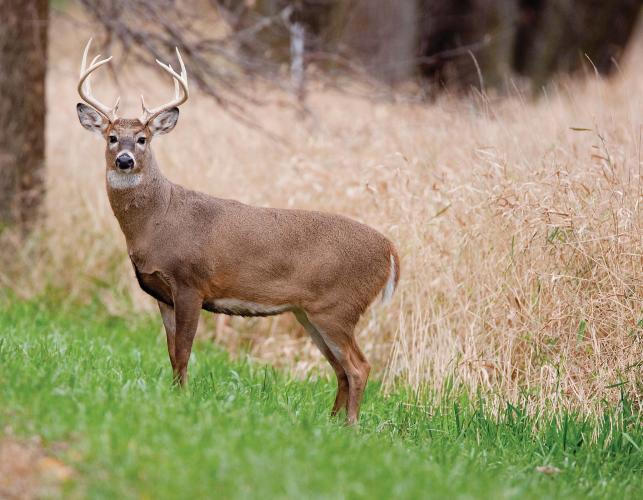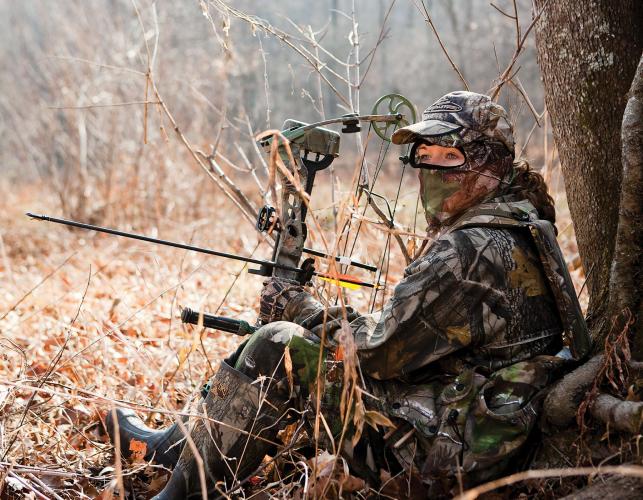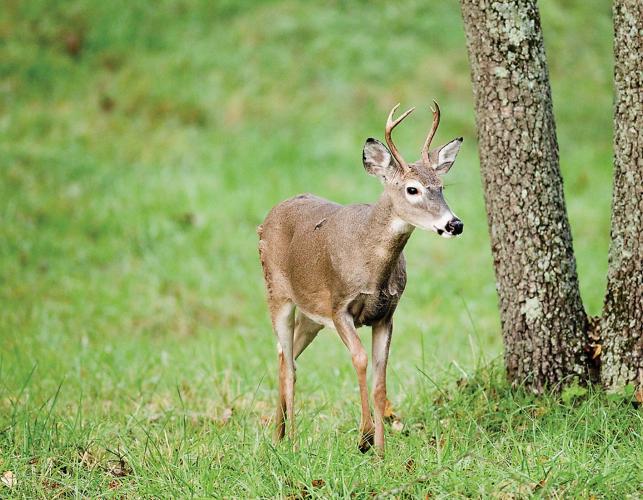As the autumn sun sets on the far ridge, I hear the faint rustling of leaves. The sound grows louder as a doe approaches upwind of my tree stand. In years past I would have made the slow, deliberate movements to get into position and wait for a nice broadside shot. Not today. As she eases her way into a shooting lane, my bow remains on the hanger. I want to increase deer numbers on the property, so the decision is easy. I watch her munch on freshly dropped acorns and wander out of range.
Although antlerless permits are available in unlimited quantities for both archery and firearms seasons in the county I hunt, I had already decided to pass on does months earlier. It is important to remember that unlimited antlerless permits provide flexibility for landowners and hunters to make management decisions that are appropriate for their individual situations—they are not site-specific harvest recommendations. For me, the right decision was to not use an available antlerless permit and let the doe walk—hopefully to raise a few more healthy fawns.
Appropriate doe harvest is a vital part of successful deer management and one of the most misunderstood. As a deer biologist for the Department of Conservation, a frequent question I get from hunters and landowners is “how many does should I shoot?” On the surface, this might seem like a pretty simple question to answer; however, many factors must be taken into consideration. In this article, I’ll explain the role of antlerless harvest limits and provide landowners and hunters with a practical guide to make harvest decisions that meet their management goals.
Antlerless Harvest Limits
The Department of Conservation sets antlerless deer limits on a county-by-county basis. The Department’s deer management goal is to maintain deer populations at levels that provide adequate opportunities for hunters and people who enjoy watching deer, but low enough to minimize crop and landscape damage and deer-vehicle accidents. The availability of antlerless permits in any number is intended to provide landowners and hunters with the flexibility to make harvest management decisions that are appropriate for their property and deer management goals. The availability of antlerless permits does not necessarily mean that hunters need to harvest more does in that county.
More than 90 percent of Missouri is in private ownership and, as a result, landowners largely dictate the distribution of hunters and hunting pressure. There are a number of factors that create differences in deer numbers.
- Variation in ownership patterns
- Property size
- Hunter density
- Habitat condition
- Fawn recruitment (number of fawns surviving to the fall)
- Sex ratio (number of does per buck)
The variability in individual landowners’ deer management goals creates a dynamic landscape in terms of deer numbers over even small distances.
Inside the Numbers
There is no question that an increase in hunting opportunities combined with unlimited antlerless permits, implementation of antler point restrictions and localized hemorrhagic disease outbreaks have reduced deer numbers in several northern, central and western Missouri counties from peak population levels in the mid-2000s. Liberalization of harvest regulations on antlerless deer has helped to stabilize and even decrease deer numbers in many areas where significant damage and deer numbers were too high. As deer numbers have decreased and reach more acceptable levels, the continued availability of antlerless permits is concerning to hunters in some counties. A look inside the numbers reveals some important trends regarding the use of antlerless permits.
Despite the unlimited availability of antlerless permits, only 1 percent of archery hunters and 2 percent of firearms hunters harvest three or more deer. Of the 9,270 individuals harvesting deer on archery antlerless permits, 93 percent harvested two or fewer antlerless deer. Of the 65,026 individuals harvesting deer on firearms antlerless permits, 95 percent harvested two or fewer antlerless deer. While the vast majority of hunters are not utilizing these permits, limiting them would reduce landowners’ ability to shoot the number of does appropriate to their specific management goals.
If we take a closer look at the harvest impacts of reducing antlerless permits from unlimited to one, we predict a 10–15 percent decrease in total antlerless harvest. If we went from unlimited antlerless to two antlerless permits, we might expect a 5–8 percent decrease in total antlerless harvest.
As we continue to investigate ways to better manage deer numbers, an additional category of antlerless permits could provide a finer degree of control than what is currently provided by zero, one or unlimited antlerless permits. However, a reduction in the availability of antlerless permits does not guarantee that those permits will be used in the appropriate locations. Ultimately, landowners and hunters are the key to management of deer populations. They are the ones who control harvest and dictate local deer numbers.
Property Specific Harvest Rates
The quantity of antlerless permits available helps the Department to manage deer numbers at the county level. However, landowners and hunters can do a great deal to maintain deer numbers at the local level. There are three simple guidelines for managing deer populations.
- To reduce deer numbers—harvest more does than antlered bucks.
- To maintain deer numbers—harvest equal numbers of does and antlered bucks.
- To increase deer numbers—harvest very few does and mostly antlered bucks.
While these generalizations will get you headed in the right direction, more specific recommendations require the collection of data. There are three types of data that are most useful when determining how many does to harvest.
- Harvest data
- Observation data
- Census data
Harvest Data
Harvest data is collected from every deer taken during the hunting season and any additional deer that are found dead throughout the year. It’s important to document deer that have been found dead as hemorrhagic disease outbreaks and other causes of mortality can affect harvest rates in the years to follow.
Deer populations in most of rural Missouri are limited by harvest. Therefore, the number of deer taken during the hunting seasons affects the population size, both regionally and locally. While most Missouri counties have liberal bag limits for antlerless deer, hunting pressure and deer numbers on properties vary widely. This means that making deer harvest decisions for your property based solely on county deer regulations can produce unwanted results. Because harvest has such a significant effect on deer population size, harvest data can reveal a great deal about the local deer population and help make sound management decisions. However, harvest data must be collected carefully and consistently. It is important to collect the data from each deer harvested and in the same manner every time.
At a minimum you should record the date of harvest, sex and age of every deer harvested on your property. Making harvest recommendations usually requires harvest data from the previous two or three years. By comparing harvest and observational data over a number of years, you can evaluate the effectiveness of harvest recommendations in meeting management objectives.
Observation Data
Collecting observation data is one of the easiest and most cost-effective methods for gathering information on the composition of a deer herd. When collected and analyzed appropriately, observational data can be extremely useful in determining several important deer herd population characteristics, such as relative deer abundance, fawn recruitment, age structure and sex ratio.
The only tools required are a pencil, paper and binoculars. The process can be as simple as recording the number of bucks, does and fawns seen and the length of time spent hunting.
Observation data can be collected at any time. The most important part is that it is collected at the same time from year to year so that you have consistency for annual comparisons. Collection of observation data during the archery season before the November firearms season can provide a good indicator for annual comparisons of deer numbers.
Actual deer abundance can’t be determined from observation data. It can show population trends. Annual comparisons of the number of bucks and does sighted per hour, along with the number of fawns per doe, are good indicators of the trend in deer populations. This observational data serves as a measure of the success of your deer management.
Census Data
Obtaining accurate census data requires the ability to collect reliable estimates of deer density on your property. Many hunters use infrared-triggered digital trail cameras to scout and pattern bucks on their property. These types of trail cameras may be the best tool available to landowners for estimating important characteristics of the deer herd on their property, including deer density, age structure, sex ratio and fawn recruitment.
Conducting a trail camera survey is relatively simple. Many hunters already have established mineral/salt licks that deer use during the spring and summer months. These sites, or other areas that deer frequently use, are great places to conduct a formal survey. Some simple guidelines for a trail camera survey are:
- One camera per 100 acres.
- Place about 50 pounds of corn approximately 12–15 feet from each camera. (Be sure to remove any bait 10 days before the start of the archery deer season.)
- Set cameras to take a photo every one to five minutes. (More frequent pictures do not result in better estimates.)
- Run the survey for 10 consecutive days in August.
- Once the 10-day survey period is complete, review the photos and count the number of bucks, does and fawns. Make special note of the number of unique bucks you have photographed.
Research indicates that with a camera per 100 acres you will successfully capture 90 percent of the deer in your hunting area.
Determining Harvest Rates
When determining the number of does to harvest, one must take into consideration several critical factors:
- Localized deer densities
- Fawn recruitment (number of fawns surviving to the fall)
- Sex ratio (number of does per buck)
These demographic characteristics can be generated from the trail camera survey described above. The size of the property you hunt and the amount of hunting pressure that occurs on the neighboring properties are also important considerations when determining doe harvest rates. Because many of us are not fortunate enough to manage large tracts of land (more than 1,000 acres), we must take into consideration what the neighbors are harvesting and adjust our expectations accordingly.
Proper collection of harvest and observation data can reveal trends in doe numbers and will serve as a guide to creating initial harvest recommendations. As you gather additional data and see changing population response to various doe harvest rates, specific harvest rates will be easier to determine. Small property managers may not obtain enough information to get meaningful results from low deer harvest numbers. One way to address the issue of limited data is to share information with neighboring properties through the formation of a deer management cooperative. Deer management cooperatives are simply neighboring landowners working together to reach common management goals. A better understanding of activities across the fence can ensure that better harvest decisions are made and increases the likelihood that everyone reaches their specific management goals.
As you go afield this fall in pursuit of Missouri’s most popular game animal, go armed not only with your weapon of choice, but a deer harvest plan. One based on your specific management goals and guided by past harvests and observations. Remember to collect data along the way so that the plan can be refined in the years to come.








This Issue's Staff
Managing Editor - Nichole LeClair Terrill
Art Director - Cliff White
Staff Writer - Bonnie Chasteen
Staff Writer - Jim Low
Photographer - Noppadol Paothong
Photographer - David Stonner
Designer - Stephanie Thurber
Artist - Mark Raithel
Circulation - Laura Scheuler






















